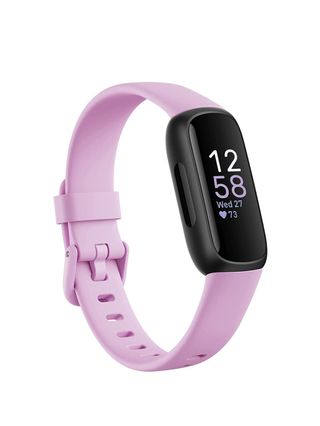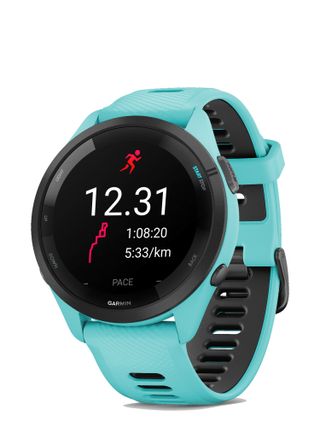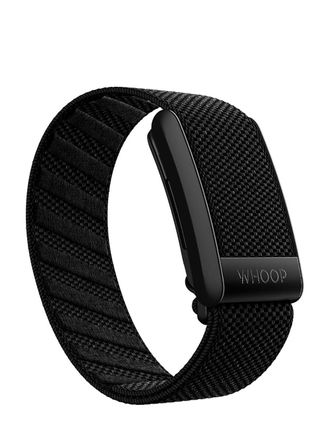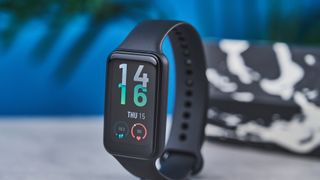Best fitness trackers 2024: Tested and rated for every budget
The best fitness trackers range from $50 to several hundred

The best fitness trackers you can buy today range in price from just under $50 to over $400. We've tested every popular model we could get our hands on, wearing them to the gym, to sleep and everywhere in between, to determine which are the most worthy of your attention and cash.
On the more affordable side, we have classic Fitbit options like the Charge 6 and Inspire 3, while on the higher-end you'll find more advanced models including the runner-focused Garmin Forerunner 265 and the Venu 3.
Of course, the best smartwatch models, like the Apple Watch 10 and Samsung Galaxy Watch 7 also double as competent workout trackers. Which is right for you? That depends on how hardcore your workout goals are, your preference toward larger or smaller devices, and how many bonus smart features you expect.
With hundreds of hours of testing under our belts to verify accuracy and battery life claims, core features and overall usability, these are the best fitness trackers you can buy right now.
The quick list

The Fitbit Charge 6 ticks all the key boxes when it comes to the best fitness trackers, offering great wearability, accurate metrics, reasonably long-lasting battery life and a bright screen, all at a very reasonable cost.

The Fitbit Inspire 3 is the best fitness tracker for those on a budget. For $100, you’re getting ten days of battery life, a colorful band and a bright screen, plus heart rate and sleep monitoring.

The Amazfit Band 7 is a lightweight and easy-to-wear fitness tracker with great battery life, good tracking accuracy, and a fairly simple user interface, all for under $50.

The Forerunner 265 is a stunning running watch and the best fitness tracker for runners with a bright, AMOLED screen and comfortable design. The watch comes in two different sizes and boasts an accurate GPS with advanced training and recovery metrics.

The Amazfit Active is a budget-friendly fitness-tracking smartwatch that won't cost you more than a Benjamin. Similar to the Amazfit Band 7 in capability, it boasts a larger and more immersive display for a little extra coinage.

The Garmin Venu 3 is a stylish and powerful fitness-tracking smartwatch with impressive battery life, intuitive sleep, workout and recovery suggestions, plus, loads of wellness metrics. It also boasts a bright touchscreen and comes in two sizes.

The Samsung Galaxy Watch 7 is another easy-wearing, full-featured smartwatch with a bright screen and impressive insights into exercise, rest, recovery and training.

The Whoop 4.0 is unlike most other trackers in this guide, with no screen to interact with. Like the Oura Ring, the Whoop is laser-focused on your workout and recovery data. It's easier to wear than many of the devices here but requires a monthly subscription.

The Apple Watch 10 is more than a fitness tracker, it’s a wrist-based extension of your iPhone that also keeps tabs on sleep, workout recovery, and even your menstrual cycle. Plus, the Series 10 is thinner and easier to view on the move than Series 9, making it the best fitness tracker for iPhone.

The Oura Ring 4 is the best fitness-tracking smart ring with detailed insights into physical activity and workout recovery. It also works with Android and iOS devices. Like the Whoop 4.0, it requires a subscription.
The best fitness trackers you can buy today
Why you can trust Tom's Guide
Best fitness tracker overall


Specifications
Reasons to buy
Reasons to avoid
The Fitbit Charge 6 is Fitbit's flagship fitness tracker and the best fitness tracker for most people. Easier to use than its predecessor thanks to a haptic side button, the Charge 6 also adds compatibility for NordicTrack, Peloton and Tonal gym equipment.
It additionally supports handy apps like Google Maps, YouTube Music and Google Wallet. However, Charge 6 users will need a Google Account now.
Of course, you buy a fitness tracker to track your fitness, and the Charge 6 does a solid job of this. Built-in GPS lets users accurately track runs, hikes and bike rides outside. It also offers support for more nuanced activities, like kickboxing, kayaking, snowboarding and rollerblading, allowing you to mix up your training.
During testing, we were impressed by how comfortable the Charge 6 is around the wrist and how easy it is to read in the bright sunlight. Simply put, the Fitbit Charge 6 is one of our favorite trackers not just for its capabilities but also for its comfort.
The re-addition of a side button and support for a small but useful selection of Google apps have made what was already a great fitness tracker even better, in our eyes. That said, Fitbit locks some metrics behind its monthly Fitbit Premium paywall, unlike other options from Garmin.
Read our Fitbit Charge 6 review here.
Best budget fitness tracker


Specifications
Reasons to buy
Reasons to avoid
The Fitbit Inspire 3 is the best value fitness tracker because it nails the basics: heart rate monitoring, accurate workout tracking and logging sleep stages. The fact that it doesn't have a built-in GPS is slightly disappointing but you can connect it to your phone's GPS for location data when necessary.
For $100, you'll get Fitbit's Active Zone Minutes metric, ten days of battery life, touch controls, and, in the biggest update from the Fitbit Inspire 2, a bright, beautiful AMOLED screen. The Fitbit unit is only available in black but is sold with three different band colors — black, lilac and morning glow. The wristband comes in two sizes: small and large.
During testing, we loved how lightweight and comfortable this little tracker was to wear for 24/7 health tracking. We also appreciated how much more premium the tracker feels with a color screen. It won't be for everyone, but if you're looking for an affordable fitness tracker, you can't go wrong with the Inspire 3. Of course, like the Charge 6, some data points require Fitbit Premium.
Read our full Fitbit Inspire 3 review here.
Best fitness tracker under $50


Specifications
Reasons to buy
Reasons to avoid
The Amazfit Band 7 is a $50 fitness tracker that promises many of the marquee features found in more premium smartwatches but at a fraction of the price. It has blood oxygen (SpO2) readings, stress monitoring, high heart rate alerts, Amazon Alexa built-in, sleep tracking and several other tools found in pricier offerings.
In our testing, the fitness and sleep tracking on the Amazfit Band 7 proved reliable and accurate. Better yet, battery life is fantastic and the device is extremely comfortable to wear day and night. There's no GPS, so you will need to carry a phone while you workout for distance and location data. If that bothers you, consider the Amazfit Bip 5 instead.
Read our full Amazfit Band 7 review.
Best fitness tracker for runners


Specifications
Reasons to buy
Reasons to avoid
Garmin makes the best sports watches you can buy, and the Forerunner 265 is one of our favorites. This mid-range Garmin running watch has a bright, beautiful AMOLED screen, which is easy to see, even in direct sunlight.
The Forerunner 265 has the addition of triathlon and multisport modes, allowing you to track all of your training in one session. The 265 also comes in two different sizes — 42mm and 46mm. We tested the smaller watch and found it extremely neat and lightweight on the wrist. Like a lot of the other best Garmins, you can also download Garmin's training plans onto the watch, helping you run and race smarter.
The Forerunner 265 also has a lot of Garmin's more premium features on board, including the Morning Report and the Training Readiness Score, both of which help you get a better understanding of your overall health.
If you're on a budget, consider the Garmin Forerunner 165, instead. It doesn't have quite as advanced training features as the 265 and lacks dual-band GPS, but it's still a great tracker for the money. Unsure which to go with? Check out our Garmin Forerunner 165 vs Forerunner 265 face-off.
Read our Garmin Forerunner 265 review.
Best fitness tracker under $100


Specifications
Reasons to buy
Reasons to avoid
The Amazfit Active is ideal for anyone who wants a budget fitness tracker without sacrificing a premium look and feel. For under $100, this humble hero packs a gorgeous 1.75” AMOLED display, which is bright, colorful and sharp. Its design is reminiscent of an Apple Watch, with a sleek matte gray or rose gold case that defies its budget price tag. If you’re looking for something with more pizzazz than the basic Amazfit Band 7, this is it.
The Active doesn’t just look good either and has the build quality to back it up. The watch is waterproof to 50 meters, is responsive to the touch and offers decent haptic feedback from its side button. It features a basic silicone strap, but Amazfit offers lots of other straps for a reasonable price.
In testing, we loved the Active’s huge range of fitness tracking features, 129 in total, and found its heart rate and intensity tracking to be on point, unlike the Fitbit Versa 4. Its strength training activity is a little fiddly, but otherwise, we had few complaints. The companion app, Zepp, displays fitness information in a high level of detail, giving you plenty of insight into your progress both short and long-term.
We also like the Amazfit Active’s health features, including sleep and menstrual cycle tracking, plus its ‘Readiness’ feature — essentially a holistic appraisal of your overall physical and mental health, which proved creepily accurate in testing. Battery life is really strong, and you can easily get 10 days of life from the watch under normal usage.
It isn’t perfect. Amazfit uses a PAI score across its devices, which is supposed to help you achieve a healthy amount of exercise for long-term health — the problem is, that it’s ludicrously hard to get anywhere near a healthy score, suggesting a flaw in Amazfit’s calculations.
Sleep tracking can be a bit iffy, despite working well most of the time, and the basic silicone strap gets uncomfortable when sweaty. At this price, though, those complaints are all pretty minor, and you shouldn’t let them put you off the Amazfit Active.
Read our full Amazfit Active review
Best Garmin fitness tracker


Specifications
Reasons to buy
Reasons to avoid
The Garmin Venu 3 is among the best Garmin smartwatches on the market today. A capable workout and wellness companion, the Venu 3 is also plenty stylish. $449 gets you a solid fitness tracker with accurate onboard GPS, mirrored smartphone notifications, an on-wrist voice assistant and more.
Garmin lacks a large third-party app store and continues to steer clear of LTE support. However, the Venu 3 does support mobile payments and provides offline music storage, allowing users to truly leave their smartphones at home without worry.
Other new features include nap-tracking and a virtual sleep coach. The Venu 3 also provides daily rest and recovery summaries along with wellness suggestions. Plus, it tracks an enormous range of physical activities. And 14 days of battery life means you won't often be reaching for a charger.
Read our full Garmin Venu 3 review.
Best fitness tracker for Android


Specifications
Reasons to buy
Reasons to avoid
The Samsung Galaxy Watch 7 is an impressive fitness tracker and one of the best smartwatches you can buy today. However, to get the most out of it, you'll need one of the best Samsung Galaxy smartphones. The Watch 7 looks identical to its predecessor but places a huge focus on the important health metrics many of us overlook: sleep and fitness recovery.
Boasting Samsung's latest sleep tracking algorithms, users get daily AI-driven insights into their sleep time, sleep cycles, movement while asleep, time it takes to fall asleep and more. The Galaxy Watch 7 is also FDA-authorized to detect sleep apnea and features the latest BioActive health sensor for monitoring everything from heart rate to blood oxygen saturation and metabolic health to menstrual cycles.
A body composition analysis tool works on the spot and Samsung's new Energy score — a daily metric based on recent workouts, recovery progress and sleep quality — is an excellent motivator to live your healthiest life. Like the Galaxy Watch 6, the newer model also has a Personalized Heart Rate Zone feature for workouts and an Irregular Heart Rhythm notification feature that detects signs of aFib.
Finally, all of the Galaxy Watch 7's fitness and health data is accompanied by custom-tailored recommendations, tips and explainers to help you gain a better understanding of your overall well-being.
Read our Samsung Galaxy Watch 7 review.
Best subscription fitness tracker


Specifications
Reasons to buy
Reasons to avoid
This one is a little different — the Whoop 4.0 isn't a fitness tracker you can go out and buy but one you subscribe to. There is no screen or in-built GPS. Instead, the Whoop band focuses on recovery and heart rate to help users better understand their body and its response to training.
The Whoop 4.0 is undoubtedly a brilliant health tracker for anyone looking for enhanced health insights — there are clear reasons why many top athletes have been spotted with one on their wrist or around their bicep. For a coach or trainer, this data is invaluable.
We've yet to touch on insights such as skin temperature, which can be used as a metric to see when your core body temperature is rising — this could be a sign a user is getting ill. The Whoop 4.0 also provides industry-leading sleep-tracking data.
Are you looking for a fitness tracker you can wear in the gym or on your run to get live feedback? If so, the Whoop is probably not for you. But if recovery metrics are your number one focus, once you get used to it, the Whoop 4.0 occupies a unique place in the market.
Read our full Whoop 4.0 review.
Best fitness tracker for iPhone


Specifications
Reasons to buy
Reasons to avoid
The Apple Watch 10 is the best Apple Watch yet, and a smartwatch I look forward to rocking daily. It’s not an enormous upgrade over the Apple Watch Series 9 but there are some important changes. The case is 10% thinner and the screen is 10% larger vs. Series 9. It's also easier to view at an angle or while on the move thanks to next-gen wide-angle OLED display tech.
The 41mm and 45mm case sizes have been retired and replaced with new 42mm and 46mm cases. The bigger of the two models boasts even more screen real estate than the Apple Watch Ultra 2. There are also new case finishes, including a rose gold and black option, and new materials, too, including lightweight titanium choices.
During testing, we found the Apple Watch 10's design improvements made it comfier to wear and easier to use. From tracking bike rides to messaging friends to navigating cities to monitoring sleep, the Series 10 can do it all. Speaking of sleep, this is the first Apple Watch with sleep apnea detection. It also features a new Training Load metric to help users avoid injury.
The device ships running the latest watchOS 11 software which delivers a new Vitals app, the ability to translate languages on your wrist, and — finally — the option to disable your Apple Watch rings when you need a rest day.
The Apple Watch 10 additionally features faster charging, the ability to play audio through the watch's speaker and a new water temperature sensor. Plus, it inherits the Ultra's water Depth app, something swimmers and snorkelers will appreciate, and advanced training metrics for runners, making it the best fitness tracker for iPhone users.
Read our full Apple Watch 10 review.
Best fitness tracker ring


Specifications
Reasons to buy
Reasons to avoid
The latest Oura Ring 4 is the best smart ring on the market today and also the best ring for keeping tabs on exercise. Available in a huge range of sizes and finishes, it isn't your typical fitness tracker.
For one, because it's a ring, it doesn’t have any buttons or physical controls. That said, while you might not be able to see your pace on the run, the Oura ring tracks just about everything else when it comes to your health, including sleep, heart rate, respiratory rate, and body temperature. It also features a 3D accelerometer for detecting movement.
While the sizing process is a little tedious, it’s essential to achieving a proper fit for something you’re supposed to wear 24/7. Once on your finger, you'll also need to pay a $5.99 monthly subscription to use the ring.
During testing, we found that the ring came into its own as a sleep tracker but is also a competent workout tracker, with support for 40+ workout types.
Post workout or rest, all of your holistic data can be viewed within the Oura app, which was recently redesigned to make it easier to see daily insights, long-term trends and an overall picture of your health. The app can also be synced with Natural Cycles to make it easier to track your menstrual cycle.
Read our full Oura Ring 4 review
Also tested
We thoroughly test every fitness tracker and fitness-focused smartwatch we can get our hands on. While not all models are destined for our best fitness tracker buying guide, there are several models that we still feel strongly are worthy of your consideration, listed below.
Amazfit Bip 5
The Amazfit Bip 5 is a lot of smartwatch for under $100 boasting a bright and colorful touchscreen, a lightweight and comfortable design, sleep tracking, onboard GPS and support for over 120 workout types.
Read our complete Amazfit Bip 5 review
Garmin Vivosmart 5
A fantastic alternative to the Fitbit Inspire 3 or Charge 6, the Vivosmart 5 also delivers accurate fitness tracking metrics in a small, comfy and affordable device. There's no onboard GPS, though.
Read our full Garmin Vivosmart 5 review
Apple Watch SE (2022)
Apple's budget-friendly smartwatch is also a competent fitness-tracking device for under $250. Unlike the Series 9, there's no skin temp or ECG sensor, but onboard GPS comes standard.
Read our full Apple Watch SE (2022) review
Features comparison
| Header Cell - Column 0 | Fitbit Charge 6 | Fitbit Inspire 3 | Amazfit Band 7 | Garmin Forerunner 265 | Amazfit Active | Garmin Venu 3 | Galaxy Watch 7 | Whoop 4.0 | Apple Watch 10 | Oura Ring 4 |
|---|---|---|---|---|---|---|---|---|---|---|
| Screen size and type | 1.4-inch AMOLED | 0.7-inch AMOLED | 1.5-inch AMOLED | 1.1-inch AMOLED (265S), 1.3-inch AMOLED (265) | 1.75-inch AMOLED | 1.4-inch AMOLED (Venu 3), 1.2-inch AMOLED (Venu 3S) | 1.5-inch AMOLED (44mm), 1.3-inch AMOLED (40mm) | n/a | 1.6-inch (42mm) and 1.8-inch (46mm) LTPO Wide‑angle OLED | n/a |
| Weight | 1.33 ounces | 0.62 ounces | 1 ounce | 1.4 ounces (265S), 1.65 ounces (265) | 0.8 ounces | 1.05 ounces (Venu 3), 0.95 ounces (Venu 3S) | 1.2 ounces (44mm) / 1 ounces (40mm) | 0.53 ounces | 1.05 ounces (42mm), 1.26 ounces (46mm) | 0.1 - 0.2 ounces |
| Battery life (tested) | 7 days / 5 hours w/ GPS | 10 days | 12 days | 15 days / 24 hours w/ GPS (265), 13 days / 20 hours w/ GPS (265) | 10 days / 16 hours w/ GPS | 14 days / 26 hours w/ GPS (Venu 3), 10 days / 21 hours w/ GPS (Venu 3S) | Up to 40 hours | 4-5 days | 18 hours (36 hours with low power mode) | 8 days |
| Waterproof rating | 50 meters | 50 meters | 50 meters | 50 meters | 50 meters | 50 meters | 50 meters | 10 meters | 50 meters | 100 meters |
| Onboard GPS | Yes | No | No | Yes | Yes | Yes | Yes | No | Yes | No |
| Mobile payments | Yes - Google Pay | No | No | Yes - Garmin Pay | No | Yes - Garmin Pay | Yes - Samsung Pay | No | Yes - Apple Pay | No |
| Subscription | Optional; $9.99 (monthly) or $79.99 (yearly) | Optional; $9.99 (monthly) or $79.99 (yearly) | n/a | n/a | n/a | n/a | n/a | $30 per month | n/a | $5.99 per month |
How to choose the best fitness tracker
When buying a fitness tracker, you should first evaluate your needs. What do you want to track? If you're only using it at the gym to count your steps and your heart rate, a simpler, less expensive fitness tracker will suit you fine.
If, however, you plan to do more outdoor activities, such as running or biking, you may want a fitness tracker with built-in GPS, so you can more accurately see where you're going, and where you went. Dedicated runners and athletes will want to check out our best GPS watches page, too.
If you plan to use the fitness tracker for swimming, you'll want to make sure it's not only waterproof, but that it can also track your laps in the pool.
Many of the best smartwatches have fitness-tracking capabilities, too, and have additional features such as responding to text messages and paying for purchases. But there are trade-offs. However, smartwatches as a whole tend to be more expensive and have shorter battery life than dedicated fitness trackers.
How we test the best fitness trackers

For each new fitness tracker, we evaluate its hardware design and comfort; you need to be able to wear the device all day, and we’ve found that some larger trackers don’t fit well on smaller wrists. If the device has a touchscreen, we look to see how readable it is, especially in bright sunlight. We also examine how easy it is to navigate the fitness trackers' menus; you don't want to have to dig through multiple screens to change your music if you're out running.
We also evaluate features such as step counting and sleep monitoring, distance calculations, and when applicable, GPS and heart rate accuracy. And, we see how well a manufacturer's battery life claims hold up in real-world testing.
Finally, we test how well a device pairs with its companion app, and evaluate the experience of using the two together. We also look to see what features the device's app supports, such as coaching and diet tracking, and if it can sync data with third-party apps, such as MyFitnessPal.
FAQs
How are fitness trackers different from smartwatches?
There's quite a lot of crossover between the best fitness trackers and the best smartwatches. Ultimately, the key difference between the two product categories is intended use.
Fitness trackers may offer some extra bells and whistles, like tap-to-pay and mirrored smartphone notifications, but their primary function is keeping tabs on your daily activity levels, exercise patterns, sleep quality, progress toward fitness goals and workout recovery.
Smartwatches, on the other hand, provide a wider range of functionality and third-party apps in addition to wellness tracking features. For example, smartwatch options in this buying guide, including the Apple Watch 9 and Samsung Galaxy Watch 7 both offer optional support for cellular connectivity. You won't find that on any fitness tracker.
This also means that the best fitness trackers tend to cost less than the best fitness-tracking smartwatches. You can expect to pay between $50 and $200 for the former and $200 to $800 and up for the latter. They also tend to be less cumbersome to wear and longer-lasting than their smarter counterparts.
Which fitness tracker brand is best, Fitbit or Garmin?
Both Garmin and Google (Fitbit) make exceptional fitness trackers. This is why two devices from each brand appear in this guide.
While Fitbits tend to be geared more toward casual workout enthusiasts, Garmin watches are designed for folks looking to take their training to the next level. For instance, devices like the Forerunner 265 and Venu 3 offer tools to help you prep for an upcoming 5K or marathon.
Garmin's top fitness-tracking devices also tend to look like smartwatches while our favorite Fitbits are more streamlined for easy-wearing. This means that the former tends to offer more screen real estate while the latter tends to be lighter and less cumbersome.
Whichever brand you choose, both Fitbit and Garmin trackers are capable of keeping tabs on your daily step count, heart rate, workouts, sleep quality, workout recovery and women's health with impressive accuracy.
Is it okay to sleep with a fitness tracker on?
Yes! In fact, all of the best fitness trackers provide some form of sleep quality tracking, so there's good reason to wear a fitness tracker to bed nightly. However, some devices offer more in-depth analysis than others.
The Samsung Galaxy Watch 7, for instance, tracks a wide array of factors while you snooze, like your body movement, heart rate, breathing data and more to determine the quality of your rest. Heck, it even monitors for snoring. This data is then paired with AI-backed insights to help you make the most of it.
Both the Apple Watch 10 and Samsung Galaxy Watch 7 also monitor for sleep apnea, a potentially serious condition that often goes undiagnosed in users.
From a comfort perspective, smaller devices like the Fitbit Charge 6 and Inspire 3, the Amazfit Band 7 and the Oura Ring 4 may be easier for folks to sleep with than bulkier options, like Garmin Venu 3.
Sign up to get the BEST of Tom's Guide direct to your inbox.
Get instant access to breaking news, the hottest reviews, great deals and helpful tips.

Dan Bracaglia is the Tom’s Guide editorial lead for all things smartwatches, fitness trackers and outdoor gear. With 15 years of experience as a consumer technology journalist testing everything from Apple Watches to instant cameras, Dan is deeply passionate about helping readers save money and make informed purchasing decisions. In 2024 so far, Dan’s tested dozens of wearables, including the latest devices from Apple, Google, Garmin, Fitbit and Samsung.
An avid outdoor adventurer, Dan is based in the U.S. Pacific Northwest where he takes advantage of the beautiful surroundings every chance he gets. A lover of kayaking, hiking, swimming, biking, snowboarding and more, he also makes every effort to combine his day job with his passions. When not assessing the GPS and heart rate accuracy of the latest Fitbit, you can find him photographing Seattle’s vibrant underground music community.


